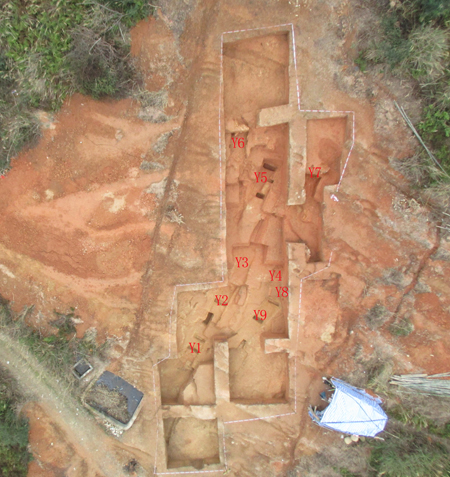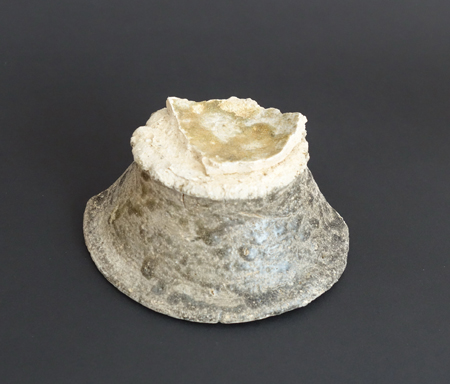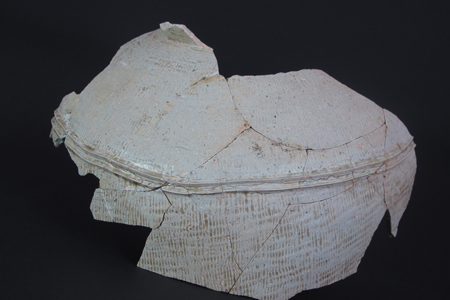Proto-celadon kiln found at Kuzhaikeng, Fujian
From:Chinese Archaeology NetWriter:Date:2017-04-18
The Kuzhaikeng site of proto-celadon kiln was located at the Yongchun County, Quanzhou City, Fujian Province. During the November and December in 2016, the Fujian Provincial Museum, collaborated with Quanzhou Municipal Museum and Yongchun County Museum conducted the archaeological excavation which covered an area of 350 square meters.Stratigraphically, there were 8 archaeological layers recovered, the depths of which gradually decreased from the hill bottom to the top. 9 dragon kilns ‘longyao’ were found densely distributed along the hillside. They were constructed by digging holes along the slopes of the hill and the early ones were destroyed by later ones.

The aerial photo illustrated the distribution of the kiln furnace
According to the C14 dating, the site covered a period from roughly the end of the 14th century BC to the middle of 18th century BC, approximately corresponding to the Xia and Shang Dynasties in Central China.
The 9 dragon kilns are chronologically divided into two phases, according to the stratigraphy of their opening and mutual relationship.

Kiln furnace remain Y2
Phase I: Kiln Y1, Y2, Y3, Y4, Y9
Kiln Y1, Y2, Y3, Y4, Y9 belong to Phase I, which dated to from the late 16th century BC to the middle of the 18th Century BC, corresponding to the middle Xia Dynasty and the beginning of the Shang Dynasty. Comparing to those later ones, kilns in this phase were generally short in length; they were approximately 3 m long and 1 m wide. In terms of the product, hard stamped pottery counted for 70% in proportion while the percentage of proto-celadon was only about 20%. The remaining 10% was contributed by the presence of kiln tools such as small round mat ‘dianbin’. Major types of ceramics included jar ‘guan’, drinking vessel ‘zun’, bowl ‘bo’ and pot (hu). Most proto-celadon vessels were coated only on outer surfaces and the enamel coat was thin in general.
PhaseII: Kiln Y5, Y6, Y7, Y8
Kiln Y5, Y6, Y7, Y8 belong to Phase 2, which dated to the late 14th century and the end of the 16th century, corresponding to the early and middle Shang Dynasty. During this phase, the shape of the kilns became gradually longer and wider, the length of which reached 3 m in general and the longest was even over 7 m in the case of the kiln Y7. Their widths ranged from 1 to 1.3 m. The proportion of proto-celadon increased and reached 30% whereas the percentage of the hard stamped pottery was around 55%, indicating a shrink in number comparing with that of Phase I. The percentage of kiln tools remained similar at around 15%. In addition to jar ‘guan’, drinking vessel ‘zun’ and bowl ‘bo’, stemmed dish ‘dou’ newly appeared during this phase. On several proto-celadon, not only outer surface was glazed, inner surface along with circle foot was also coated with enamel.
Vessel characteristics and porcelain technology
Decorations found on proto-celadon and hard stamped pottery resembled to each other, where carving, flapping, pricking, sticking and hollowing out techniques were practiced. The geometric patterns included chord, square, rhombus, circle, stripe, raised bands. Most vessels had surface decorations. On their bellies, there were mainly flapped square, rhombus and lineal patterns whereas on their shoulders they were decorated by pricked circles, pricked points together with chord and strip patterns. Strip pattern was decorated on small round mats as well, a very small number of which were decorated by square and rhombus patterns.

Proto-celadon ring foot(Y6:01)
A large number of collections found in the kilns were deliberately destroyed left with traces of smashing, which was further evidenced by the presence of ceramic fragments with sharp edges. Clay bands were used to connect and reinforce those ceramics. On the inner surface of some large vessels, there left densely packed hollows. Shapes of circle foot and rim might have been adjusted on slow-speed wheel.
During the firing stage, while most vessels were fired separately, some of them were fired in stacks in the kiln, using mats to separate them.
Local porcelain clay that could be easily accessed was used as raw material. The clay there was rich of illite, which is a clay crystalline mineral that can be easily shaped. This feature makes it ideal for producing low-temperature fired porcelain.
Importance of the discovery
First of all, the Kuzhaikeng kiln site has been the earliest kiln site producing proto-celadon found so far, thus being important to the study of the origin of the proto-celadon from the hard stamped pottery.
Secondly, the kiln structure was well preserved in the site, generally composing of firing passage, kiln room and smoke extraction room, which is a typical structure of a dragon kiln. Moreover, kiln tools appeared in Phase I to separate vessels for firing, which would have improved the efficiency of production. The evidences above provide salient information to explore the ceramic technology during the Xia and Shang Dynasties.

Proto-celadon fragment(Y2②∶8)
Thirdly, within the 2 square km survey area, over 10 kiln and residential sites have been found, which turns out to be breakthrough discovery pertaining to ancient ceramic-industry in the Fujian region.
Last but not least, the discovery of the Kuzhaikeng site partially explains the large number of proto-celadon found in the archaeological sites in the Jinjiang River region and its surrounding coastal areas. It will definitely help establishing the chronology of the Bronze Age in the region of Fujian. (Translator: Dong Ningning)

